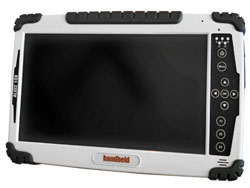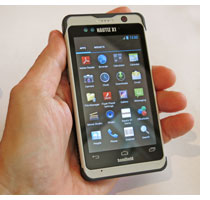« Itronix RIP | Main | How Motorola Solutions made two mobile computers condensation- and freezer-proof »
May 14, 2013
Handheld: Pursuit of a vision
I had a chance yesterday to meet over dinner with Sofia Löfblad, Marketing Director at Handheld Group AB, and Amy Urban who is the Director of Marketing at Handheld US. I hadn't seen them since I presented at the Handheld Business Partner Conference in Stockholm three years ago, and it was a pleasure catching up in person.
The Handheld Group (not to be confused with Hand Held Products, which is now part of Honeywell) is a remarkable rugged mobile computing success story. Having its origins as a distributor of vertical market mobile computers from the likes of Husky, TDS and others, Handheld went on to establish its own identity with its own distinct product lines. In fact, they call themselves a "virtual manufacturer."
What does that mean? Well, while it is not unusual for larger distributors to resell OEM products under their own name, Handheld went one step farther. They not only have their own brands (Nautiz for rugged handhelds, Algiz for rugged tablets), but also their own design language and color scheme (Sofia even knew the precise Pantone color numbers), and they often have exclusive arrangements with their OEMs. So in addition to having a very cohesive brand identity and consistent look, Handheld products are less likely to immediately be identified by industry followers as rebranded versions of a common design.
How has that worked out for the Handheld Group? Apparently quite well. They now have ten facilities all over the world, as well as several hundred authorized partners. And they've been able to score impressive wins like a contract for 10,000 rugged handhelds with Netherland Railways against much larger competition.
They also proved their knack for coming out with the right product at the right time with devices such as the Algiz 10X (a rugged but light and handy 10-inch tablet), the Algiz XRW (a super-compact rugged notebook), and the Nautiz X1, which they call the toughest smartphone in the world. On the surface, that doesn't sound all that terribly exciting, but it really is, and here's why:
I am on record as bemoaning the demise of the netbook, those small and handy notebooks that used to sell by the tens of millions. Then they disappeared due to a combination of being replaced by consumer tablets, and, even more so, an unfortunate industry tendency to keep netbooks so stunted in their capabilities as to render them virtually useless for anything but the most basic tasks. Well, now that they are gone, many wish they could still get a small, competent Windows notebook that's tough and rugged, but isn't as big, expensive and bulky as a full-size rugged notebook. And that is the Algiz XRW. I've liked it ever since I took an early version on a marine expedition to the Socorro islands a couple of years ago (see Case Study: Computers in Diving and Marine Exploration. And the latest is the best one yet (see here).
 The Algiz 10X likewise is a Q-ship (i.e. an innocuous looking object that packs an unexpected punch). On the surface, it's just a rugged legacy tablet, albeit a remarkably compact and lightweight version. And while that is mostly what it is, the 10X hits a sweet spot between old-style rugged tablet and new-style media tablet. One that will likely resonate with quite a few buyers who still need full Windows 7 and full ruggedness on a tablet and also some legacy ports, all the while also wanting a bright wide-format hi-res screen and a nice contemporary look.
The Algiz 10X likewise is a Q-ship (i.e. an innocuous looking object that packs an unexpected punch). On the surface, it's just a rugged legacy tablet, albeit a remarkably compact and lightweight version. And while that is mostly what it is, the 10X hits a sweet spot between old-style rugged tablet and new-style media tablet. One that will likely resonate with quite a few buyers who still need full Windows 7 and full ruggedness on a tablet and also some legacy ports, all the while also wanting a bright wide-format hi-res screen and a nice contemporary look.
Then there's the Nautiz X1 rugged smartphone, and that's a real mindblower. By now there are quite a few attempts at providing consumer smartphone functionality in a tougher package, but none as small, sleek and elegant as the Nautiz X1.  It measures 4.9 x 2.6 inches, which is exactly the size of the Samsung Galaxy S2 (the one before Samsung decided to make the displays almost as big as a tablet). At 0.6 inches it's thicker, and it weighs 6.3 ounces, but for that you get IP67 sealing (yes, totally waterproof), a ridiculously wide -4 to 140 degree operating temperature range, and all the MIL-STD-810G ruggedness specs you'd usually only get from something big and bulky. Which the Nautiz X1 definitely is not.
It measures 4.9 x 2.6 inches, which is exactly the size of the Samsung Galaxy S2 (the one before Samsung decided to make the displays almost as big as a tablet). At 0.6 inches it's thicker, and it weighs 6.3 ounces, but for that you get IP67 sealing (yes, totally waterproof), a ridiculously wide -4 to 140 degree operating temperature range, and all the MIL-STD-810G ruggedness specs you'd usually only get from something big and bulky. Which the Nautiz X1 definitely is not.
In fact, with its gorgeous 4-inch 800 x 480 pixel procap screen, Android 4.x, and fully contemporary smartphone guts, this is the tough smartphone Lowe's should have looked at before they bought all those tens of thousands of iPhones (see here). Don't get me wrong—I adore the iPhone, but it's devices like the Handheld Nautiz X1 that belong in the hands of folks who use smartphones on the job all day long, and on jobs where they get dropped and rained on and so on.
I don't know if Handheld is large enough to take full advantage of the remarkable products they have. They've done it before with that big contract in the Netherlands. But whatever may happen, it's hard not to be impressed with their fresh and competent products that go along with their great people, and their fresh and competently executed business plan.
Posted by conradb212 at May 14, 2013 3:59 PM















